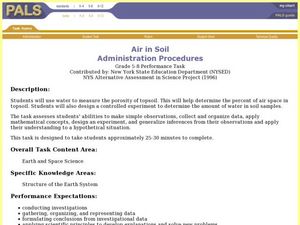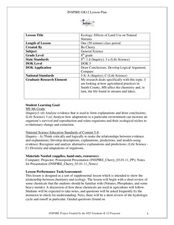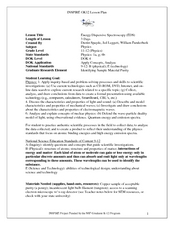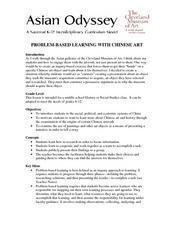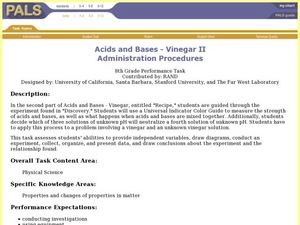Curated OER
Air in Soil Administration Procedures
Students study soil and its composition. In this soil composition lesson, students study examples of soil during several days of aeration. Students summarize their data, organize it, and must be able to explain their findings.
Curated OER
Measurement: When Degrees Matter
Eighth graders record the temperature change of the beakers. In this general science lesson, 8th graders create their own data table for recording observations. They discuss experimental results and cite real life applications.
Curated OER
Don’t be a Stoic about Stoichiometry
Students review balancing chemical equations. In this chemistry lesson, students calculate moles of an unknown substance based on stoichiometric relationships in the balanced equation. They cite applications of stoichiometry in the real...
Curated OER
Ecology: Effects of Land Use on Natural Streams
Eighth graders examine how humans affect various ecosystems. In this ecology instructional activity, 8th graders discuss different ways that contaminants enter the stream. They explain the consequences of eutrophication in lakes.
Curated OER
2D Kinematics w/ String Racers
Students calculate the speed of string racers. In this physics lesson plan, students measure the time in several trials and get the average. They graph their results using a spreadsheet.
Curated OER
Ions in the Environment
Students explain the importance of the five main biogeochemical cycles. In this chemistry lesson plan, students discuss how ions are transported in the environment. They design an experiment to collect data on eutrophication.
Curated OER
The Wildland/Urban Interface Dilemma
Students examine all sides of the issues surrounding wildland fire. Groups assume the roles of different people who must decide what to do about a fictitious wildfire. They have a discussion to analyze the issue. A good, real life...
Curated OER
Energy Dispersive Spectroscopy
Students calculate the values of electron binding energies. In this physics instructional activity, students solve for different wavelength characteristics of X-rays. They present their findings to the class.
Curated OER
Automated Vehicle Programming Design
Students design a program to make an automated vehicle perform a specific task. In this robotics lesson, students play the role of scientists competing to win a factory's contract. They present their algorithm to class.
Curated OER
I Have the Solution!
Students explain how to make solutions with specific concentration. In this chemistry lesson, students differentiate acids and bases. They calculate molarity of solutions.
Curated OER
Problem-Based Learning With Chinese Art
Students form small, cooperative learning groups, research a major Chinese dynasty and present their findings to the classroom in this multi-day instructional activity adaptable to many different age levels.
Curated OER
Detection Detective
Young scholars describe what each detection method uses and rank the wavelengths of each if appropriate. They answer questions about absorption, importance of materials and explain differences. Students make sure they describe diagnostic...
Curated OER
Plants Releasing Water
Third graders investigate how water is released from different plants into the atmosphere. They observe and investigate two types of plants with domed lids with condensation and communicate those observances and inquiries on an in-class...
Curated OER
Robot Turning Lab
Students design a robot that can turn 90 degrees. In this robotics lesson, students explain the applications of their invention. They present their design in class.
Curated OER
Robot Labyrinth
Students design a flowchart for their robotic program. In this physics lesson, students construct a robot that can navigate certain obstacles. They present their program and robots in class.
Curated OER
Sensor Challenge
Students develop a pseudo code flowchart for their robotic program. In this physics lesson, students construct a robot that can navigate through certain obstacles. They test their robot and present them to class.
Curated OER
Robot Olympics
Students design a robot based on given requirements. In this technology lesson, student test whether their robots can perform certain tasks. They present and discuss their program design.
Curated OER
Highways and Stop Signs
Fourth graders investigate conductors and insulators and distinguish between the two. They utilize the digital camera and other forms of technology to create a study guide on conductors to help students develop sound knowledge.
Curated OER
Observation and Discovery
Students explore the basic skills guiding sound scientific invvestigation and methodology. They are introduced to a powerful scientific tool-the microscope. Students review the parts of the microscope. They discuss the inventor of the...
Curated OER
Acids and Bases - Vinegar II
Eighth graders experiment what happens when acids and bases are mixed together. In this acids and bases experimental lesson, 8th graders decide which of three solutions of unknown pH will neutralize a fourth solution of unknown pH.
Curated OER
Plant Phylogeny
Students examine live potted plants and create a hypothesis regarding their relationships in this upper-level introductory lesson on phylogenetic reconstruction using morphological characters. The lesson can be accomplished in...
Curated OER
The Reservations
Third graders investigate the concept of a reservation and how it effects the lives of Native American indian tribes. They conduct research with the help of guiding questions to find the correct type of information. Students take notes...
Curated OER
Heroes, Elders, Historic Figures, Contemporary Tribal Leaders
Fifth graders research famous Elders. They receive a list of Elders, Historic Figures and Contemporary Tribal Leaders (included with the lesson). They discuss the Essential Question to guide their research. Students take notes based on...
Curated OER
Blood Business
Young scholars identify the different kinds of blood. In this biology lesson, students investigate the antigens, agglutinins and Rh factor using their own blood. They use Punnett squares to predict blood type of offspring.


